
38 Leda is a large, dark main-belt asteroid that was discovered by French astronomer J. Chacornac on January 12, 1856, and named after Leda, the mother of Helen of Troy in Greek mythology. In the Tholen classification system, it is categorized as a carbonaceous C-type asteroid, while the Bus asteroid taxonomy system lists it as a Cgh asteroid. The spectra of the asteroid displays evidence of aqueous alteration.
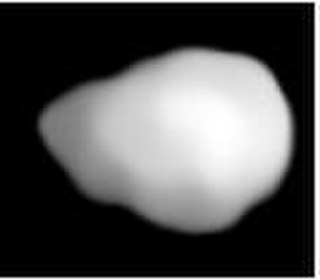
41 Daphne is a large asteroid from the asteroid belt. It is a dark-surfaced body 174 km in diameter is probably composed of primitive carbonaceous chondrites. The spectra of the asteroid displays evidence of aqueous alteration. It was discovered by H. Goldschmidt on May 22, 1856, and named after Daphne, the nymph in Greek mythology who was turned into a laurel tree. Incorrect orbital calculations initially resulted in 56 Melete being mistaken for a second sighting of Daphne. Daphne was not sighted again until August 31, 1862.

64 Angelina is an asteroid from the central region of the asteroid belt, approximately 50 kilometers in diameter. It is an unusually bright form of E-type asteroid.

105 Artemis is a main-belt asteroid that was discovered by J. C. Watson on September 16, 1868, at Ann Arbor, Michigan. It was named after Artemis, the goddess of the hunt, Moon, and crossways in Greek Mythology.

111 Ate is a main-belt asteroid discovered by the German-American astronomer C. H. F. Peters on August 14, 1870, and named after Ate, the goddess of mischief and destruction in Greek mythology. In the Tholen classification system, it is categorized as a carbonaceous C-type asteroid, while the Bus asteroid taxonomy system lists it as an Ch asteroid.

120 Lachesis is a large main-belt asteroid. It was discovered by French astronomer Alphonse Borrelly on April 10, 1872, and independently by German-American astronomer Christian Heinrich Friedrich Peters on April 11, 1872, then named after Lachesis, one of the Moirai, or Fates, in Greek mythology. A Lachesean occultation of a star occurred in 1999 and was confirmed visually by five observers and once photoelectrically, with the chords yielding an estimated elliptical cross-section of 184 × 144 km.
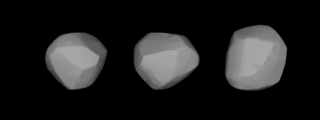
146 Lucina is a main-belt asteroid that was discovered by Alphonse Borrelly on June 8, 1875, and named after Lucina, the Roman goddess of childbirth. It is large, dark and has a carbonaceous composition. The spectra of the asteroid displays evidence of aqueous alteration.
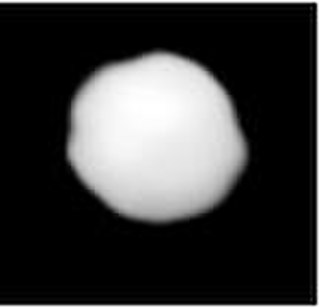
145 Adeona is a large asteroid from the intermediate asteroid belt, approximately 150 kilometers in diameter. Its surface is very dark, and, based upon its classification as a C-type asteroid, is probably composed of primitive carbonaceous material. The spectra of the asteroid displays evidence of aqueous alteration. The Adeona family of asteroids is named after it.

200 Dynamene is a large dark main-belt asteroid that was discovered by German-American astronomer Christian Heinrich Friedrich Peters on July 27, 1879, in Clinton, New York. The name derives from Dynamene, one of the fifty Nereids in Greek mythology. Based upon its spectrum, 200 Dynamene is classified as a C-type asteroid, indicating that it probably has a primitive composition similar to the carbonaceous chondrite meteorites. The spectra of the asteroid displays evidence of aqueous alteration.
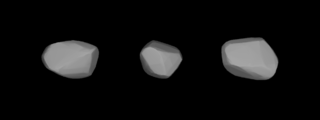
516 Amherstia was the 8th asteroid discovered by Raymond Smith Dugan, and was named after Amherst College, his alma mater. Amherstia is a large M-type main belt asteroid, with an estimated diameter of 73 km. It follows an eccentric orbit between Jupiter and Mars, with an orbital period of 4.39 years. The orbital plane is inclined at an angle of 13° to the ecliptic.
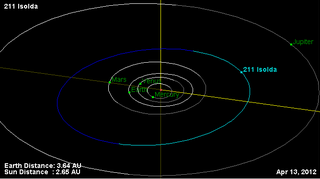
211 Isolda is a very large, dark main-belt asteroid. It is classified as a C-type asteroid and is probably composed of primitive carbonaceous material. The spectra of the asteroid displays evidence of aqueous alteration.

247 Eukrate is a rather large main-belt asteroid. It is dark and probably a primitive carbonaceous body. The asteroid was discovered by Robert Luther on March 14, 1885, in Düsseldorf. It was named after Eucrate, a Nereid in Greek mythology.
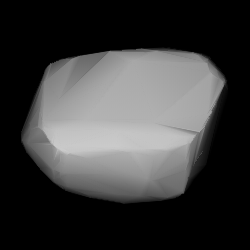
334 Chicago is a very large main-belt asteroid. It is classified as a C-type asteroid and is probably composed of carbonaceous material.
356 Liguria is a very large main-belt asteroid that was discovered by Auguste Charlois on January 21, 1893, in Nice. It is one of seven of Charlois's discoveries that was expressly named by the Astromomisches Rechen-Institut, and was named for the Italian region.

386 Siegena is a very large main-belt asteroid. It is classified as a C-type asteroid and is probably composed of primitive carbonaceous material.
444 Gyptis is a main-belt asteroid that was discovered by J. Coggia on March 31, 1899, in Marseilles. It is classified as a C-type asteroid and is probably composed of carbonaceous material. The spectra of the asteroid displays evidence of aqueous alteration.
449 Hamburga is a carbonaceous asteroid from the background population of the intermediate asteroid belt, approximately 75 kilometers in diameter. It was discovered by German astronomers Max Wolf and Friedrich Schwassmann at Heidelberg Observatory on 31 October 1899, and later named after the city of Hamburg in Germany.
488 Kreusa is a C-type asteroid orbiting the Sun in the asteroid belt, with the type indicating a surface with a low albedo and high carbonaceous content. The spectra of the asteroid displays evidence of aqueous alteration.
712 Boliviana is a C-type asteroid from the asteroid belt, with the type indicating the surface has a low albedo with high carbonaceous content. The spectra of the asteroid displays evidence of aqueous alteration. It is named after Simón Bolívar.

784 Pickeringia is a large background asteroid, approximately 76 kilometers in diameter, located in the outer region of the asteroid belt. It was discovered on 20 March 1914, by American astronomer Joel Hastings Metcalf at the Winchester Observatory in Massachusetts. The dark C-type asteroid has a rotation period of 13.1 hours and an irregular shape. It was named after American astronomers Edward Charles Pickering (1846–1919) and his brother William Henry Pickering (1858–1938).

















